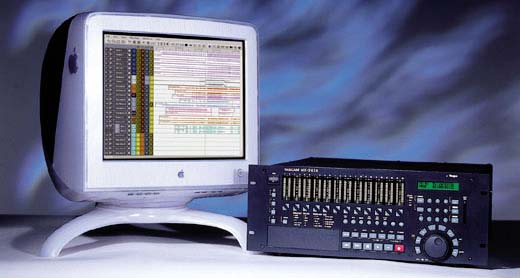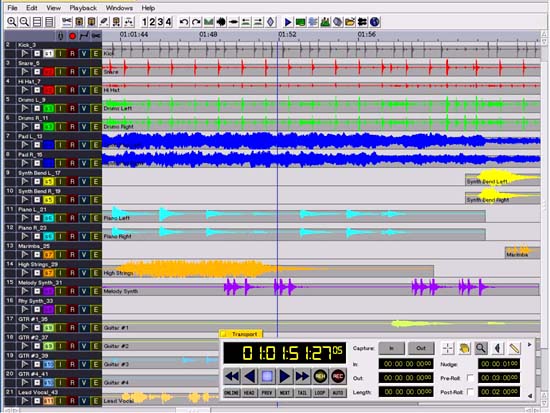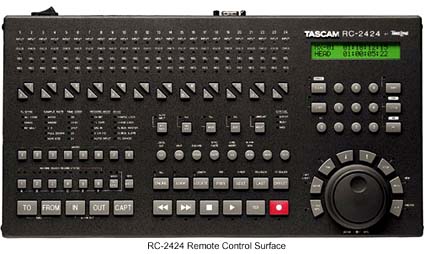FUTURE STYLE
|
24 Track 24 Bit Hard Disk Recorder |

|
You don't need a computer, a monitor, a
keyboard and a mouse to edit your audio on the MX-2424. At
the same time, you're not limited to just cutting, copying
and pasting your audio. Here's a list of editing controls
that are all accessible from the MX-2424's front panel
alone: Cut, Local Cut, Left Cut , Left Local Cut, Copy,
Paste, Paste Left, Multi Paste, Paste at Playhead, Clear,
Open, Insert, Multi Insert, Split, Discard, Sync Paste, Sync
Insert, Nudge Left, Nudge Right, Render, Redo, Undo ,
Reverse. |

|
MX-View: on board editing software graphic interface MX-View is a brand new editing interface for TASCAM's MX-2424 . Offering a sophisticated graphic editing interface that's comparable to full-featured digital audio workstations, MX-View lends powerful editing capabilities to the MX-2424. Running natively on both Mac and Windows platforms, MX-View was custom designed specifically for the MX-2424. MX-View is a quick and responsive editor, with the ability to view waveforms down to the sample level. You can repair clicks and pops with the pencil tool, select and nudge audio events to the correct beat, drag and drop audio files with the hand tool, fade, crossfade and trim events on the fly. In addition to replicating the extensive front panel controls of the MX-2424, MX-View offers a slew of new features and capabilities based on its standard 100 Megabit Ethernet interface. MX-View allows you to transfer individual and groups of audio files to your computer and back, as well as letting you back up entire projects. The MX-View interface also functions as a complete system interface for as many MX-2424s as you wish. Multiple MX-2424s can be displayed and edited on the screen simultaneously, there's no need for a separate monitor for each machine. Plus, each machine's meters can be clearly seen from the MX-View windows, making it a thorough remote control interface. MX-View's interface is also customizable and designed ergonomically. Buttons and windows can be hidden as needed, and color-coded edit groups makes editing across multiple track a snap. Keyboard command sets may be configured by users to their liking, and windows like the transport, locate markers, and level meter can be moved around freely and stored as a user preference. MX-View overview Native Macintosh and Windows versions Scrolling real-time tracks with waveforms Sample level waveform editing, including Pencil tool for repair of clicks and pops Drag and drop editing on the fly (during playback too) 24 track onscreen meters for accurate level metering of up to six MX-2424s Edit on up to six MX-2424s simultaneously in one window Break-point style volume automation and event based gain automation Floating, dockable and re-sizable windows for custom configuration Flexible interface allows hide/show of buttons and docking windows to maximize screen editing area 12 color-coded edit groups for editing across multiple tracks Computer Ethernet backup/restore and audio file transfer with verify function Custom configurable keyboard command sets Selectable linear and custom fades and crossfades Easy virtual track and project file management Repeat Paste editing commands for seamless looping Batch Fade processing Locator window with up to 100 named locate points Floating transport window for easy access and quick navigation MX 2424 Specifications Analog I/O Capacity: (6) D-Sub 25F connectors, 8 input or 8 output channels per connector. 24 in/out channels total. AES/EBU I/O Capacity: (3) D-Sub 25F connectors, 8 input and 8 output channels per connector. 24 in/out channels total. TDIF I/O Capacity: (3) D-Sub 25F connectors, 8 input and 8 output channels per connector. 24 in/out channels total. ADAT I/O Capacity: (3) ADAT Optical connector pairs, 8 input or 8 output channels per connector. 24 in/out channels total. Quantization: 24 bits, A/D and D/A Sample Rate: 38.5kHz to 54 kHz with 24 I/O channels; 77.2kHz to 108kHz with 12 I/O channels Analog Input & Output Level: +4dBu balanced, +22dBu ±1dBu clip, not adjustable Analog Frequency Response: 20Hz-20kHz, ±0.2dB @ 48kHz. 10Hz-40kHz, ±3dB @ 96kHz. Headroom: 18dB above nominal input level (IF-AN24). 20dB above nominal input level (IF-AN24EH). Analog Input Impedance: 10k Ohms balanced Analog Output Impedance: <75 Ohms balanced THD+N (Through): <0.004% @ 1kHz @ clip level -0.5dB THD+N (A/D): <0.001% typical @ 1kHz @ clip level -0.5dB THD+N (D/A): <0.003% typical @ 1kHz @ clip level -0.5dB Dynamic Range (Through): >106dB (20Hz-22kHz, A-wtg.) Dynamic Range (A/D): 109dB typical (20Hz-22kHz, A-wtg.) Dynamic Range (D/A): 111dB typical (20Hz-22kHz, A-wtg.) Signal-to-Noise Ratio (Through): >106dB (10Hz-22kHz, A-wtg.) Crosstalk (Through): <-95dB between any channels (20Hz-20kHz) Digital Option THD+N (Through or Record, linear): Adds no distortion to source material AES/EBU Option Sample Rate Conversion:0.33 to 3 input range to internal sample rate. Sample rate conversion may be enabled on all 24 channels simultaneously.AES/EBU THD+N (through w/SRC): <0.003% typical @ 1kHz @ clip level -0.5dB Sample Length, Recording: 16-bit linear or 24-bit linear Sample Length, Internal: 24-bit Standard Audio I/O: (1) AES/EBU input on F XLR, (1) AES/EBU Output on M XLR, (1) S/PDIF input on F coaxial, (1) S/PDIF on F coaxial Defeatable input SR convert Timing Reference Sources: Internal, Internal Varispeed, Follow time code in, Video (either NTSC or PAL), AES/EBU, S/PDIF digital clock input, Word clock input, TL-Bus Internal Sample Rates (in Hz): 44056, 44100, 44144, 47952, 48000, 48048, 88112, 88200, 88288, 95904, 96000, 96096 External Sample Rates: 38.5kHz - 108kHz (via external word clock input) Time Code Type and Rate: 23.976/24, 24/24, 24.975/25, 25/25, 29.97/DF, 30/DF, 30/NDF Nominal Operating Temperature: 41º-95º Fahrenheit (5º-35º Centigrade) Relative Operational Humidity: 30%-90% (non-condensing) Autoswitching Power Supply: Nominal: 100-240VAC, 1.5-0.8A, 150W, 50/60Hz; Absolute Minimum/Maximum: 85-264VAC, 50/60 Hz Analog Input/Output Voltage: 9.75VRMS Maximum MX-2424 Dimensions: 19" wide x 17.5" deep x 7" high (48.28cm x 44.45cm x 17.78cm), 4U rackmount MX-2424 Weight: Approximately 31 lbs (14kg) with all optional cards installed RC-2424 Dimensions: 15" wide x 8" deep x 2" high (20.32cm x 38.1cm x 5.08cm) RC-2424 Weight: 3.38 lbs (1.5kg) File Types and disk drives for compatibility everywhere Why do you need to have a
recording/editing system that's compatible with other
equipment? There are several reasons. You may have a
preference regarding other audio tools that offer recording,
processing and editing capabilities. Example: you like to
work in the realm of your favorite computer-based audio
system but want to track using the MX-2424. SCSI Hard Drives Why SCSI drives for the MX-2424 ? At 24 tracks, the demand for sustained speed in reading/writing files to disk is critical. The MX-2424's SCSI architecture lets you perform functions like seamless punch ins/outs on all 24 tracks at once and playing across sections with high densities of editing, which may not be possible with other drive formats. SCSI drives are also very robust. Though every hard disk recorder should be backed up to media other than hard drives, the internal Quantum Atlas V drive is rated for 300Gs of impact. Perhaps the best reason for going with a SCSI-based hard disk recorder is its compatibility with other systems. The MX-2424 lets you choose to format its hard drives for specific compatibility with Mac or PC. You could take a drive from the MX-2424, connect it to a compatible computer, and access the audio data in your computer editing system , all without powering down your system if you are equipped with a hot-swappable drive system. Plus, an MX-2424 project has files and folders so you can copy selected audio files (or an entire session). MX-2424 Interfaces and
Peripherals
Unless you can flexibly route your audio
and data around your studio, your hard disk recorder might
as well be a doorstop. The MX-2424 provides plenty of
options for getting analog and digital signals to consoles
and other studio tools. It even allows you to send and
receive digital and analog signals simultaneously.
MX-2424 Backup Solutions Though hard disk recording offers amazing creative advantages over tape-only systems, hard drives themselves are vulnerable to physical damage. Even the world's sturdiest drives, like our Quantum Atlas V drives that are rated to handle 300Gs of impact, are susceptible to losing an album's worth of material from an accidental drop on a hard studio floor. The backup options Following is a listing of MX-2424 backup
peripherals available from TASCAM. All prices are in US
Dollars. Onboard Synchronization Word Clock In, Out and Thru: Ensures that the sampling rate of connected equipment is properly aligned. SMPTE Time Code In, Out and Thru: Locks the MX-2424 to any device that receives or generates SMPTE time code. Beware of other recorders that only chase in "Lock and Release Mode" which can cause drift over time. MIDI In, Out and Thru: For controlling the MX-2424 via MIDI Machine Control and MIDI Time Code. Video In and Thru: Allows the MX-2424 to lock with a blackburst signal from video. TL-Bus In and Out: the MX-2424's own synchronization interface that allows for up to 32 machines (768 tracks at 48kHz or 384 tracks at 96kHz) to be locked with sample accuracy without the need for any external synchronizer. 2-channel AES/EBU and 2-channel S/PDIF:
Can automatically clock the MX-2424 or transfer audio with
devices that use these digital protocols, like CD recorders
and DAT machines
|
 advanced technologic sound magazine 2001 issue
99
|








